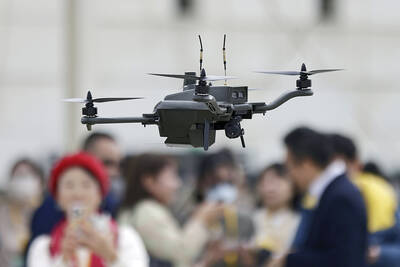US fears that an indigenous satellite launcher capability for Taiwan could help it develop longer-range missiles may have forced Taipei to abandon, or at least delay, the project, sources told the Taipei Times.
After years of relying on foreign space-launch capabilities to lift payloads into space, reports began emerging in 2008 that Taiwan’s National Space Program Office (NSPO) had long-term plans to develop an indigenous satellite and launcher for scientific use.
At the Fourth Asian Space Conference that year, a paper presented by NSPO officials said the agency’s first choice to launch FORMOSAT-6, a micro-satellite under development to carry out scientific investigation, would be the Taiwan Small Launch Vehicle (TSLV).
Another paper presented at the same conference by engineers from various Taiwanese universities said the Taiwan Universities United Satellite NO. 1A, a scientific satellite developed by NSPO in conjunction with a consortium of Taiwanese universities, was expected to be launched by the TSLV, built by the Chung-Shan Institute of Science and Technology (CSIST, 中山科學研究院), into a circular orbit of 500km and at 21 degree inclination.
A cable from the American Institute in Taiwan (AIT) dated April 6, 2009, reported that then-NSPO director-general Miau Jiun-jih (苗君易) had informed the AIT five days earlier that the agency’s long-term plan called for Taiwan to develop an indigenous satellite and launcher and that Taiwan was “very keen for US reaction to that plan.”
The cable said Miau had told the AIT that the TSLV would be locally built in cooperation with CSIST and used to propel locally made satellites weighing between 50kg and 200kg into orbit. A test launch for a 50kg satellite — very likely FORMOSAT-6 — was scheduled for next year to collect data on disaster management and environmental observation.
Based on the lack of progress in developing a TSLV, it appears the US reaction to the plan was negative. US analysts have told the Taipei Times that the involvement of CSIST, the Ministry of National Defense’s principal research and development institution, in the TSLV project, as well as Taiwan’s decision to proceed with the development of the Hsiung Feng-IIE (HF-2E) land-attack cruise missile, may have ensured US opposition to the plan.
According to an October 2009 report by Defense News, in the middle of 2006 the US Department of State began requesting end-user certificates for all export items destined for CSIST and AIT officials were instructed to obtain permission prior to meeting anyone from the research institute. Sources said the intent was to destroy Taiwan’s ability to develop an indigenous missile program, specifically the 600km range HF-2E, and “appease Beijing.”
In January the same year, Taiwan announced it had built three prototypes of the missile and intended to start mass production. US opposition to Taiwan’s missile program was such that a defense expert has linked the development of the HF-2E to Washington’s initial decision to turn down a request by Taipei for 66 F-16C/D aircraft. It is also alleged that a head of CSIST was denied a visa to the US in retaliation for the development of the missile.
The US government regards the HF-2E as an offensive weapon and therefore against the spirit of the Taiwan Relations Act, which stipulates US assistance to Taiwan for weapons and services of a “defensive character.”
Taiwan argues it needs a counterforce arsenal to deter China and to retaliate against missile launch sites in case of attack.
Late last year, the Ministry of National Defense announced it was about to embark on mass production of the HF-2E.
Under Missile Technology Control Regime regulations, and to prevent an arms buildup in the Taiwan Strait, the US Department of State has continually blocked the transfer of missile components to Taiwan to prevent it from building smaller warheads and achieving longer range.
The possible military derivatives associated with the TSLV, especially in achieving delivery of heavier payloads over a longer range for its indigenous missiles, are believed to have played a major role in the US’ decision not to support the NSPO’s launcher plan.
A US official speaking on condition of anonymity said that the US Department of Defense had stayed away from Taiwan’s development of space launch capability, adding that this article’s assessment of US apprehensions over the launcher program, CSIST’s role in it and possible military uses was “correct.”
Asked for comment, AIT spokesperson Christopher Kavanagh said AIT employees and US officials had regular contacts with a broad range of organizations in Taiwan, including CSIST.
However, citing policy on WikiLeaks, Kavanagh would not comment on material included in the AIT cable relating to the NSPO plans for satellite launcher capability. He also declined to confirm whether a visa application by the head of CSIST had been denied.
Taiwan's interest in developing the TSLV appears to have since evaporated.
Contacted for this article, NSPO Deputy Director-General Yu Shiann-jeng (余憲政) said the development strategy at his organization was to concentrate resources on the FORMOSAT-5 and FORMOSAT-7 programs.
“The so-called TSLV is not on the development agenda,” he said in an e-mailed response on Friday, comments that would contradict remarks quoted in the AIT cable by Miau in 2009.
The FORMOSAT-5 is scheduled to be launched by Space Exploration Technologies Corp, a US space transport firm, in 2014 on board a Falcon-1e launch vehicle, while FORMOSAT-7, a joint venture between Taiwan and the US and which would replace the ageing FORMOSAT-3, is under review at the National Science Council.
The launch date for FORMOSAT-6 appears to have been pushed to 2013 or 2014, reportedly as a result of bureaucratic delays and funding inadequacies.

The combined effect of the monsoon, the outer rim of Typhoon Fengshen and a low-pressure system is expected to bring significant rainfall this week to various parts of the nation, the Central Weather Administration (CWA) said. The heaviest rain is expected to occur today and tomorrow, with torrential rain expected in Keelung’s north coast, Yilan and the mountainous regions of Taipei and New Taipei City, the CWA said. Rivers could rise rapidly, and residents should stay away from riverbanks and avoid going to the mountains or engaging in water activities, it said. Scattered showers are expected today in central and

COOPERATION: Taiwan is aligning closely with US strategic objectives on various matters, including China’s rare earths restrictions, the Ministry of Foreign Affairs said Taiwan could deal with China’s tightened export controls on rare earth metals by turning to “urban mining,” a researcher said yesterday. Rare earth metals, which are used in semiconductors and other electronic components, could be recovered from industrial or electronic waste to reduce reliance on imports, National Cheng Kung University Department of Resources Engineering professor Lee Cheng-han (李政翰) said. Despite their name, rare earth elements are not actually rare — their abundance in the Earth’s crust is relatively high, but they are dispersed, making extraction and refining energy-intensive and environmentally damaging, he said, adding that many countries have opted to

SUPPLY CHAIN: Taiwan’s advantages in the drone industry include rapid production capacity that is independent of Chinese-made parts, the economic ministry said The Executive Yuan yesterday approved plans to invest NT$44.2 billion (US$1.44 billion) into domestic production of uncrewed aerial vehicles over the next six years, bringing Taiwan’s output value to more than NT$40 billion by 2030 and making the nation Asia’s democratic hub for the drone supply chain. The proposed budget has NT$33.8 billion in new allocations and NT$10.43 billion in existing funds, the Ministry of Economic Affairs said. Under the new development program, the public sector would purchase nearly 100,000 drones, of which 50,898 would be for civil and government use, while 48,750 would be for national defense, it said. The Ministry of

UNITED: The other candidates congratulated Cheng on her win, saying they hoped the new chair could bring the party to victory in the elections next year and in 2028 Former Chinese Nationalist Party (KMT) lawmaker Cheng Li-wun (鄭麗文) yesterday won the party’s chair election with 65,122 votes, or 50.15 percent of the votes. It was the first time Cheng, 55, ran for the top KMT post, and she is the second woman to hold the post of chair, following Hung Hsiu-chu (洪秀柱), who served from 2016 to 2017. Cheng is to succeed incumbent Eric Chu (朱立倫) on Nov. 1 for a four-year term. Cheng said she has spoken with the other five candidates and pledged to maintain party unity, adding that the party would aim to win the elections next year and